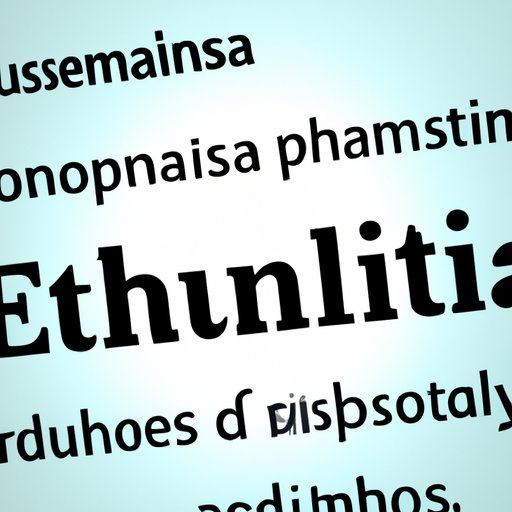Introduction
Euthanasia is defined as a practice that intentionally ends a person’s life in order to relieve them from suffering. It is often referred to as “mercy killing” or “assisted suicide” and is highly controversial due to its ethical implications. This article will explore how does euthanasia work by looking at the legal, ethical, and religious perspectives surrounding this controversial practice. Additionally, it will examine the types of euthanasia, the role of medical professionals, and the impact of euthanasia on families and communities.

Exploring the Ethical Debate Surrounding Euthanasia
The ethical debate surrounding euthanasia has been ongoing for centuries. There are those who believe that euthanasia should be allowed in certain cases, such as when a person is suffering from a terminal illness or is in extreme pain. On the other hand, there are those who argue that euthanasia goes against the sanctity of human life and should not be permitted under any circumstances. To better understand the ethical debate, it is important to consider both sides of the argument.
Overview of Arguments
Proponents of euthanasia argue that it is an act of mercy and compassion and can help to relieve a person’s suffering. They believe that individuals should be able to make decisions about their own life and death, and that euthanasia can provide a compassionate way to end a life that has become unbearable. Opponents of euthanasia argue that it is a violation of human rights and can lead to abuse and misuse of the procedure. They believe that euthanasia goes against the natural order of life and death and that it should not be allowed in any circumstance.
Pros and Cons of Euthanasia
Proponents of euthanasia point to the fact that it can provide relief from physical pain and suffering, allowing a person to die with dignity. Additionally, they argue that it can provide emotional comfort to family members and friends who are struggling to cope with a loved one’s terminal illness. Opponents of euthanasia argue that it puts too much power in the hands of doctors and that it could be used to terminate the lives of vulnerable individuals who cannot make decisions for themselves. They also point out that it can lead to a slippery slope, where individuals may start to view life as disposable.

Examining the Legality of Euthanasia in Different Countries
The legality of euthanasia varies from country to country. In some countries, such as Belgium and The Netherlands, euthanasia is legal and regulated by law. In other countries, such as the United States and Canada, euthanasia is illegal but certain forms of physician-assisted suicide are allowed. Additionally, some countries have taken a stance of neutrality on the issue, allowing individuals to make their own decisions about euthanasia without fear of legal repercussions.
Overview of Laws
In countries where euthanasia is legal, there are typically laws in place to regulate the procedure. These laws typically require a patient to have a terminal illness, to be in unbearable physical or mental pain, and to have requested euthanasia multiple times before it can be carried out. Additionally, the laws usually require a second opinion from another doctor and the approval of a third party before the procedure can take place.
Examples of Legalization
Belgium was the first country to legalize euthanasia in 2002, followed by The Netherlands in 2003. Since then, several other countries have legalized euthanasia, including Luxembourg (2009), Canada (2016), and Colombia (2017). Additionally, several states in the US have passed legislation allowing for physician-assisted suicide, including Oregon (1997), Washington (2008), and Vermont (2013).
Understanding the Types of Euthanasia and Their Pros and Cons
Euthanasia can be divided into two main categories: voluntary and involuntary. Voluntary euthanasia is when a patient requests to end their life, while involuntary euthanasia is when a patient is unable to make the decision themselves. Additionally, there are two subcategories of voluntary euthanasia: active and passive. Active euthanasia is when a person is actively killed, while passive euthanasia is when treatments are withheld or withdrawn to allow a person to die naturally.
Overview of Types
Voluntary active euthanasia is when a person actively requests to end their own life, usually with the assistance of a doctor. This type of euthanasia is typically only allowed in countries where euthanasia is legal. Involuntary active euthanasia is when a person is killed without their consent, which is illegal in most countries. Voluntary passive euthanasia is when a person refuses medical treatment in order to end their life, while involuntary passive euthanasia is when medical treatment is withheld or withdrawn from a person without their consent.
Pros and Cons for Each Type
Proponents of voluntary active euthanasia argue that it can provide relief from unbearable pain and suffering and allows a person to die with dignity. Opponents of this type of euthanasia argue that it takes away a person’s right to life and can lead to abuse and misuse of the procedure. Proponents of voluntary passive euthanasia argue that it respects a person’s right to choose and can provide peace of mind to family members. However, opponents of this type of euthanasia argue that it can lead to unnecessary deaths and can be used to target vulnerable individuals.
Exploring the Role of Medical Professionals in Euthanasia
Medical professionals play an important role in the practice of euthanasia. Physicians are responsible for determining whether or not a patient meets the criteria for euthanasia and must ensure that all guidelines are followed. Additionally, they must provide counseling to patients and their families and must be prepared to deal with the emotional consequences of carrying out the procedure.
Responsibilities of Physicians
Physicians must ensure that all legal and ethical requirements are met before performing euthanasia. They must obtain informed consent from the patient and must ensure that the patient has requested euthanasia multiple times. Additionally, they must provide counseling to the patient and their family and must be prepared to deal with the emotional consequences of carrying out the procedure. Furthermore, physicians must adhere to professional guidelines and must be aware of the potential risks associated with euthanasia.
Guidelines for Care
The World Health Organization has issued guidelines for medical professionals regarding the practice of euthanasia. These guidelines include obtaining informed consent from the patient and ensuring that the patient has requested euthanasia multiple times. Additionally, the guidelines state that physicians must provide counseling to the patient and their family and must be prepared to deal with the emotional consequences of carrying out the procedure. Finally, the guidelines emphasize that physicians must adhere to professional guidelines and must be aware of the potential risks associated with euthanasia.
Investigating the Religious Perspectives on Euthanasia
Religious beliefs can vary greatly when it comes to the practice of euthanasia. Some religions, such as Christianity and Judaism, oppose euthanasia, while others, such as Buddhism and Hinduism, are more accepting of the practice. Additionally, some religions do not have a formal stance on the issue, leaving it up to individuals to make their own decisions.
Overview of Beliefs
Christianity and Judaism both oppose euthanasia, citing the belief that life is a gift from God and should not be taken away prematurely. Buddhism and Hinduism, on the other hand, are more accepting of the practice, viewing it as an act of compassion and mercy. Additionally, some religions do not have a formal stance on the issue, such as Islam and Sikhism, allowing individuals to make their own decisions about euthanasia.
Examples of Religious Traditions
The Catholic Church has long opposed euthanasia, citing the belief that life is a gift from God and should not be taken away prematurely. Other Christian denominations, such as Lutherans and Anglicans, also oppose euthanasia, while some Protestant denominations, such as Methodists and Presbyterians, are more open to the idea. Additionally, some religions, such as Buddhism and Hinduism, are more accepting of the practice, viewing it as an act of compassion and mercy.

Examining the Impact of Euthanasia on Families and Communities
The impact of euthanasia on families and communities can be significant. For families, the decision to end a loved one’s life can be emotionally difficult and can cause a great deal of stress and grief. Additionally, the decision can affect the entire community, as it can lead to a shift in attitudes towards life and death. Understanding the potential impact of euthanasia is important for making an informed decision about the issue.
Effects of Euthanasia on Family
For families, the decision to end a loved one’s life can be emotionally difficult. It can cause a great deal of stress and grief for family members, as well as feelings of guilt and regret. Additionally, the decision can cause tension between family members, as some may disagree with the decision while others may support it. It is important for families to discuss the issue openly and honestly and to seek support if needed.
Impact on Community
The decision to end a life can also have an impact on the wider community. It can lead to a shift in attitudes towards life and death, as well as a change in the way people view medical care and end-of-life decisions. Additionally, it can lead to a greater acceptance of euthanasia in society, as well as an increase in the number of people requesting the procedure. It is important for communities to discuss the issue openly and honestly and to consider all viewpoints before making a decision.
Conclusion
Euthanasia is a highly controversial practice that has been debated for centuries. This article has explored how does euthanasia work by looking at the legal, ethical, and religious perspectives surrounding the issue. It has examined the types of euthanasia and their pros and cons, the role of medical professionals, and the impact of euthanasia on families and communities. Ultimately, it is important to consider all perspectives before making a decision about euthanasia.
(Note: Is this article not meeting your expectations? Do you have knowledge or insights to share? Unlock new opportunities and expand your reach by joining our authors team. Click Registration to join us and share your expertise with our readers.)
